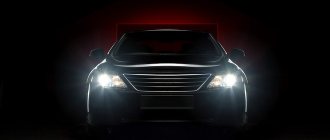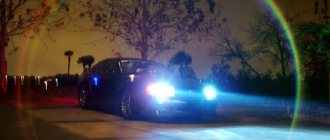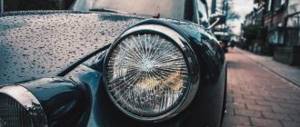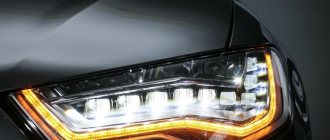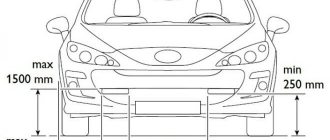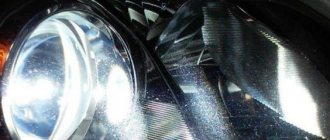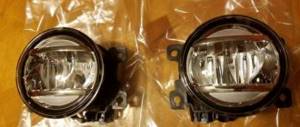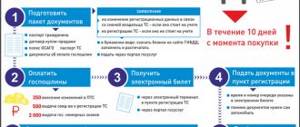What do the traffic rules say, are there any changes since June?
And the traffic rules still unambiguously and unconditionally establish in clause 19.5 that during daylight hours, drivers of any moving vehicles are required to use running lights or use low beam headlights to indicate their vehicle.
Below is a paragraph of the rules without distortion.
This means that you are required to drive with low beams or running lights at any time of the year during daylight hours, if the latter are provided for by the design of your car.
Alternatively, drivers can use fog lights in combination with low beam and running lights. Just don’t confuse the classic “dimensions” with running lights.
But where did the rumor about the abolition of low beam headlights come from?
This is interesting: Should you turn on headlights during the day?
Fine amount
Three days ago Andrey from Moscow asked me a question. He was compensated that he was given a ticket for his low beam headlights not working. I was very indignant and wanted to appeal this in court. I explained to him that now they could actually be punished for this.
For several years now, in Russia there has been a rule according to which drivers must drive with low beams or fog lights on. Moreover, this rule applies at any time of the day and in any weather.
| Penalty calculator for not turning on low beams: | |
| What was the violation? | |
| Has 20 days passed since receiving the fine or drawing up the report? | |
You can travel, but not with us
And the whole point is that on the territory of Belarus from May 25 to June 6, a special event was held due to the end of the school year.
As part of this campaign, all drivers were required to drive with their headlights on even during the daytime, since the Belarusian traffic rules do not require driving with the lights on.
Since June 6, this requirement has lost force in the neighboring Republic, but a number of news publications, without understanding it, interpreted it to our traffic regulations.
The requirement to turn on the lights during the day was also canceled in Uzbekistan - the corresponding provision came into force in June of this year.
We note once again that there have been no changes in Russian traffic regulations regarding the abolition of the obligation to turn on low beams during the day .
LED bulbs
Some drivers like to drive with rear fog lights on all the time. It is unacceptable. You can only use them in poor visibility conditions. Although you can use front fog lights.
Remember that the factory presets certain lamps that you can use. If you decide to replace them with more powerful ones, you may also be fined for this.
If you want to make any changes, consult with specialists and traffic police officers. You can get permission from them to use a certain type of headlights.
According to statistics, having low beams on helps make the situation on the road safer. The number of road accidents is decreasing. This is especially noticeable when a gray car is driving on a cloudy day. Without low beams it can easily be missed.
If you get caught by a good inspector, you can get off with a regular warning, without receiving a fine.
Remember, if you constantly drive with your low beams on, after 3-4 years your headlight reflectors will completely burn out. They will need to be replaced in this case. It is for this reason that during the day and during daylight hours it is better to drive with fog lights.
The cost of replacing fog lights is much cheaper than replacing low beams.
If you have the opportunity, you can install daytime running lights. They are now installed on many cars directly at the factory. With them you will definitely not forget to turn on the headlights. They work according to the following principle. As soon as you start the car, they immediately turn on automatically.
Low beam when driving in the year (traffic rules)
Every year, drivers try to find an answer to the problem: should they turn on low beams during the day? Traffic regulations regarding the movement of vehicles with low beam lighting have not undergone significant changes over the past two years (2018, 2019). Clause 19.5 of the traffic rules indicates the mandatory introduction of low beams when moving during the day. Extract from the rules:
Point 19.4 is immediately considered:
In accordance with the two points, it is possible to use DRLs or foglights instead of low-beam headlights.
There is no need to confuse daytime running lights and dimensions.
There is also a definition about running lights in the traffic rules. They belong to external illumination devices and are necessary to identify the vehicle from the front of it in the daytime.
No laws regarding outdoor lighting have been introduced since April 1; these are all myths that are confirmed by legal documents.
How to drive at night
At night within the city limits, only low beams should be used. A city street at night is illuminated by lanterns, shop windows, etc., so high beams are allowed only in unlit areas.
When driving on the highway, you must switch the light to high beam; the color of the headlight is allowed within the temperature range of 3000–5400 Kelvin. It is necessary to turn on low beam instead of high beam:
- If a vehicle is moving towards you, the distance is at least 150 m.
- If an oncoming driver signals that he was blinded by the headlights of your car.
- During an overtaking maneuver, the driver is allowed to “blink” his high beams to warn traffic participants, clause 19.11 of the Russian Traffic Regulations.
To increase the power of high beams, many motorists install xenon in halogen headlights. Such conversion of optics is considered a violation of the rules. If the high beam exceeds the color temperature parameters that are allowed on public roads (white-blue light no more than 5600 K, brightness no more than 1500 L), the inspector has the right to invite the driver to open the hood to see if there is an ignition unit for the xenon lamp.
What's happened?
According to the innovation, in our country, from April 1, there is no obligation to turn on headlights during daylight hours - specifically low beam and even daytime running lights. That is, something happened to clause 19.5 of the traffic rules, which reads:
During daylight hours, low-beam headlights or daytime running lights must be turned on on all moving vehicles for the purpose of identifying them.
According to various sources, the new law has the following types:
- According to the change, it is allowed not to turn on low beam headlights during the day only in the summer or snowless seasons - from April 1 to September 30 of each year. The reasoning is simple: in summer the daylight hours are much longer than in winter, therefore there is simply no need to use lighting devices;
- You don’t have to turn on the low beams, but daytime running lights are definitely necessary - a strange statement, in fact, because today, even without changes to the traffic rules, this is prescribed;
- In Russia, headlights on have been completely abolished during the daytime - that is, in any season on any car you can not use external lighting devices (except for turn signals, of course) during the day.
This is interesting: How to dilute g11 antifreeze
You can no longer turn on the low beam headlights
The Rules of the Road, paragraph 19.5, tell us that any moving vehicle must indicate itself with BS or daytime running lights. Clause 19.4 allows the use of fog lights to identify vehicles.
Violation of these rules is subject to a written warning from a traffic police officer or a fine under one of two articles of the Code of Administrative Offenses of the Russian Federation:
- Article 12.20 says that if the driver simply forgot to indicate his vehicle with light signals, then he may receive a warning or a fine of 500 rubles;
- Article 12.5 says that the driver must pay the same fine of 500 rubles if one or both headlights are faulty. In this case, operation of the vehicle is prohibited until the malfunction is eliminated. The same applies to glasses that are too dirty and burnt out light bulbs.
A complete list of documents required to issue a card.
There is also a controversial point that many car enthusiasts forget or do not take into account.
During the day, the driver uses fog lights and enters the tunnel, and at the exit receives a fine for not turning on the headlights in accordance with traffic rules.
He is stopped by a traffic police officer because the driver violated paragraph 19 of traffic rules.
1, which establishes that when entering a tunnel it is necessary to switch from the fog lights to the low beam. The same goes for DRLs.
In addition to these rules, traffic rules allow the use of BS as a supplement to side lights (but not instead of them) in conditions of poor visibility. This is not so important, since such a car poses a danger primarily to passing vehicles.
At the beginning of 2006, all Russian drivers were required to use BS during the daytime when driving outside populated areas. As of October 20, 2010, this paragraph was revised, and now every driver is required to turn on the headlights or DRLs when driving on any highway.
Failure to comply with these rules is punishable by a fine of 500 rubles or a warning, so motorists had no choice but to start complying with it. However, debate about how effective and relevant this rule is has not subsided.
Some said that a car marked with a light is easier to see in conditions of poor visibility (in fog, heavy rain, twilight and in the forest), while others complained that due to such a rule, fuel consumption would be higher and the bulbs would burn out more often.
Let's try to figure this out.
In total, BS light bulbs, dimensions and license plate lights require about 150 W of power. LED DRL lamps - approximately 15 W. In comparison, an air conditioner requires 4500 watts, approximately 30 times more.
Therefore, a thrifty car enthusiast should first of all refuse the air at a comfortable temperature in the cabin, and not the switched on light bulbs.
If we translate power into fuel consumption, then BS lamps and other lighting increase consumption by approximately 100 ml of gasoline per hour.
Prices for tachograph cards can be found here.
New laws regarding car headlights and external lighting devices in general have not been introduced in our country for a long time.
But just recently, an alleged change in the current traffic rules appeared - low beam headlights in the daytime in Russia now do not need to be turned on, at least in the summer.
According to various sources, the new law comes into force on April 1, 2021. Is this true, we have figured out all the changes to the Rules and other regulations!
In mid-March 2021, the network was overwhelmed with news that supposedly from April 1, another change would come into force, abolishing the obligation to turn on headlights during the day in Russia. There are no references either to the initiators of the bill or to the official documents amending the traffic rules. And the news was spread mainly through Telegram and WhatsApp messengers.
According to the innovation, in our country, from April 1, there is no obligation to turn on headlights during daylight hours - specifically low beam and even daytime running lights. That is, something happened to clause 19.5 of the traffic rules, which reads:
During daylight hours, low-beam headlights or daytime running lights must be turned on on all moving vehicles for the purpose of identifying them.
According to various sources, the new law has the following types:
- The change extends the permission not to turn on low beam headlights during the day only during the summer or snowless seasons - from April 1 to September 30 of each year. The reasoning is simple: in summer the daylight hours are much longer than in winter, therefore there is simply no need to use lighting devices;
- You don’t have to turn on the low beams, but daytime running lights are definitely necessary - a strange statement, in fact, because today, even without changes to the traffic rules, this is what is prescribed;
- In Russia, headlights on have been completely abolished during the daytime - that is, in any season on any car you can not use external lighting devices (except for turn signals, of course) during the day.
No. It is not true. Low beam headlights or DRLs still need to be turned on during daylight hours. No new laws regarding external lighting devices have been introduced either since April 1, 2021, or... even back in 2014. And changes specifically regarding light are not planned.
Everything is very simple. There are 2 possible “proofs”.
Another argument against changes in the Traffic Rules is the edition of the traffic rules. With each change, a new edition comes into force.
Today, the most up-to-date database on them is contained on the Consultant Plus website.
And here you will find 3 editions: one that entered into force on March 18, 2021, and 2 more that are pending.
But most importantly, none of them has in the list of changes section 19 of the traffic rules, which specifically concerns lighting devices.
As you can see, no changes have been introduced to the traffic rules since April 1, 2021, and you still need to turn on your headlights during the day.
So, the traffic rules today regulate the following rules for the use of headlights.
Night time:
- low or high beam (see below conditions when you cannot use high beam) when driving,
- near and/or rear PTFs together with dimensions when parking on unlit sections of roads (it is not necessary to turn on the near ones, but the dimensions are required),
- only on unlit roads and only together with a neighbor or a distant driver.
Insufficient visibility (fog, rain, etc.):
- low or high beam (see below conditions when you cannot use high beam) when driving,
Daylight hours (any of the following):
- Daytime Running Lights,
- dipped headlights,
- front fog lights.
There is no need to turn on the taillights during the day.
Tunnels:
- low or high beam (see below for conditions when high beam cannot be used).
When not to use high beam headlights:
- on an illuminated road in populated areas,
- closer than 150 meters from oncoming traffic,
- further than 150 meters from the oncoming traffic, if the driver of the oncoming car blinks his headlights,
- in any case where you may blind drivers.
Direct blinding of pedestrians by distant traffic regulations is not prohibited.
One of the following lighting fixtures must be used:
- low beam headlights;
- high beam headlights.
In this case, the main beam cannot be used:
- in populated areas on illuminated roads;
- when oncoming vehicles pass;
- when blinding drivers of passing or oncoming cars.
The rules for using headlights and flashlights in various situations are discussed in detail above, but remembering them is not so easy. Therefore, we will consider them in a more compact form.
Prohibited:
- use the rear fog lamp when visibility is good;
- use high beams in populated areas on illuminated roads, when passing oncoming traffic, when blinding passing or oncoming drivers;
- do not use low or high beams at night, with insufficient visibility, in a tunnel;
- do not use DRLs, low beams or PTF during the day;
- Do not use clearance when parking in poor visibility conditions or on an unlit section of the road at night.
What light to use in conditions of poor visibility (in fog)?
The conditions of insufficient visibility are also defined in the Rules, so there is no ambiguity here. These conditions include driver visibility of less than 300 meters in fog, twilight, rain, snow, and the like. In general, if the visibility of the road is approximately less than 300 meters, the only time it is night, then these are conditions of insufficient visibility.
In conditions of insufficient visibility, you need to turn on:
- dipped or high beam headlights when moving (see above in the description of lighting at night, in what conditions you cannot use high beams);
- side lights when stopping and parking - low beam headlights, fog lights or rear fog lights together with side lights can also be turned on in conditions of poor visibility (as opposed to the dark).
- fog lights - only in combination with low or high beam headlights (and on roads of any illumination, as opposed to the dark).
- rear fog lights (this is the only condition in which they can be used).
In conditions of insufficient visibility, you cannot use:
- fog lights without low or high beam headlights;
- daytime running lights.
What light should I use in the tunnel?
Traffic regulations regulate the mandatory inclusion of headlights in tunnels (clause 19.1). The rule here is simple: the conditions for using certain lighting devices are the same as in the dark.
How should we use lighting devices today?
So, the traffic rules today regulate the following rules for the use of headlights.
Night time:
- low or high beam (see below conditions when you cannot use high beam) when driving,
- near and/or rear PTFs together with dimensions when parking on unlit sections of roads (it is not necessary to turn on the near ones, but the dimensions are required),
- only on unlit roads and only together with a neighbor or a distant driver.
Insufficient visibility (fog, rain, etc.):
- low or high beam (see below conditions when you cannot use high beam) when driving,
Daylight hours (any of the following):
- Daytime Running Lights,
- dipped headlights,
- front fog lights.
There is no need to turn on the taillights during the day.
Tunnels:
- low or high beam (see below for conditions when high beam cannot be used).
When not to use high beam headlights:
- on an illuminated road in populated areas,
- closer than 150 meters from oncoming traffic,
- further than 150 meters from the oncoming traffic, if the driver of the oncoming car blinks his headlights,
- in any case where you may blind drivers.
Direct blinding of pedestrians by distant traffic regulations is not prohibited.
This is interesting: Emergency button as a must
Fines
The traffic rules clearly regulate how to use head and additional vehicle lighting depending on weather conditions, time of day and terrain. It is important for drivers to remember that the law prohibits traffic police officers from unauthorizedly opening the hood of a car or removing a headlight while checking what type of lamp is installed in the unit.
The inspector stops the car if he visually observes the following violations:
- Headlight adjustment does not comply with GOST. This is visible to every road user: distant lights blind passers-by and illuminate not the road strip, but the horizon.
- The lights don't work or are very dirty.
- The headlights do not have lenses or use lamps that are not standard for a particular model.
In addition to a fine of up to 3,000 rubles, for some violations the driver faces losing his license for a period of 6 months to a year.
For xenon
If xenon headlights are installed on a car instead of standard halogen lights and the inspector, without a technical inspection, determines that such brightness is not typical for halogen low or high beam lighting, the following will follow:
- Drawing up a protocol.
- Sending the vehicle to the inspection station.
- Checking the compliance of lighting devices with standard ones.
- Fine up to 3000 rubles. plus deprivation of rights for a period of 6–12 months if it is discovered that halogen lights have been replaced with xenon.
Xenon in foglights is also subject to fines and deprivation of rights. When choosing xenon for PTF, it is recommended to choose a lamp with a color temperature of up to 3000 K. The yellow headlight block will reduce the range of the light beam, visibility will improve without changing the brightness.
LED lamps
There is no penalty for diode bulbs in headlights if this type of light is specified by the manufacturer. If the basic version of the car in the model range has halogen installed, and a more equipped version has standard diodes, the driver can replace the halogen lamp with a diode one. Automakers provide this option for car models of the same generation.
Installing diode elements instead of the standard halogen allows you to significantly increase the brightness of the headlight, while the lighting parameters will be within the limits of the rules. It is impossible to determine which lamp is in the headlight unit without disassembling the latter. Diodes, depending on the number of blocks, provide soft, even light, do not overheat the diffuser and have a long service life.
Despite all the advantages of LED blocks, LED bulbs installed without permission also face a fine of 500 rubles. They may also be deprived of their rights for up to 12 months.
To install LEDs in headlights legally, you need to complete the following steps:
- Purchase optics that correspond to the car model range.
- Re-equip the lighting system in the car.
- Visit the traffic police department (at the place where the car is registered), fill out an application for changes to the design of the vehicle.
- Pass a technical inspection and make amendments to the diagnostic card.
- Write out a certificate.
If the lamp burns out
If a car is driven with the headlights off, regardless of the reason (a light bulb has burned out, inattention, the wrong light is on, etc.), the driver faces a fine of 500 rubles. In some cases, a fine can be avoided:
- If the motorist convinces the inspector that the headlight became inoperative a few minutes ago.
- A fine for a non-working headlight will not be collected if the car is traveling in the direction of the service and there is confirmation - a call to the service station.
- Motorists can only receive a verbal warning for not having their headlights on if it is a first inattention offense.
- If all the headlights are on during the day, this is not a violation; such a point is not provided for by the rules. Therefore, the inspector may simply advise not to discharge the battery.
The most common reasons for a fine for lack of lighting:
- For driving a vehicle with one headlight.
- When entering the tunnel, they forgot to turn on the low or high beams; they thought that PTF or DRLs were enough.
- There is no switching of lights at night when vehicles are passing.
- Broken lenses do not allow you to correct the beam of light, which blinds oncoming drivers.
- Using DRLs at night without headlights.
The installation of additional headlights, as well as headlights, is permitted only in accordance with the dimensions of the car.
For repeated violation of the rules for the use of lighting devices on a vehicle, in 80% of cases, in addition to a fine, the driver will be deprived of his license.
There is no fine for “blinking headlights”. In rare cases, the inspector finds fault with the driver and tries to charge him with “illegal use of a light device,” but the driver can always answer that he did this, warning oncoming motorists about a possible overtaking maneuver on his part.
Changing something good only spoils it
“Now the old rules continue to apply; no new amendments to the traffic rules regarding lighting devices have been adopted,” says Pyotr Shkumatov. But there is one point hidden in the traffic rules, around which the controversy began.
The fact is that the latest amendments to paragraph 19.5 of the traffic rules were approved in 2010. They have significantly tightened the rules for the use of lighting devices on vehicles. If previously passenger cars were required to drive during the day with lights only outside the city, then in the new edition of the traffic rules this has become mandatory within populated areas. Meanwhile, 8 years ago there was some relaxation. It was allowed to use daytime running lights instead of low beam headlights. The literally edited clause 19.5 of the traffic rules read: “During daylight hours, low-beam headlights or daytime running lights must be turned on on all moving vehicles for the purpose of identifying them.”
Apparently, the addition “or daytime running lights” has caused so many discrepancies and interpretations. Some drivers thought that instead of bright low beams during the day, they could limit themselves to dim headlights. What does this lead to?
Is it possible to cut a turn through a solid road and how to avoid deprivation of rights? More details
The main myth about low beam headlights
It lies in the fact that fuel consumption with constantly working low-beam headlights is supposedly noticeably higher. In fact, if there is a difference, it is barely noticeable - a maximum of 100 milliliters of gasoline per hour. Can this be called significant material costs? Of course not. Therefore, turning on car headlights during the day will have little impact on the family budget, but will protect you from getting into an accident and the associated health risks. Thus, there is no reason to break the law. Over time, doing it will become a habit, just like caring for those who are next to you on the road.
When can you blink your headlights?
Yes, most often drivers blink their headlights (one or more short-term switches of headlights from low beam or DRL to high beam) when warning oncoming vehicles about traffic police officers. However, traffic rules recommend doing this in completely different cases. Which ones:
- to warn other road users about overtaking;
- if you are blinded by an oncoming vehicle.
At the same time, nowhere in the Rules is there a direct prohibition on blinking headlights. However, traffic police officers may regard this as a violation of traffic rules, as a result of which you can easily earn a fine of 500 rubles. Think for yourself, when you blink you turn on the high beams, but in most cases it is prohibited to turn them on.
As you can see, everything is very simple! But let's simplify these Rules for the use of lighting devices even further and present everything in a visual tabular form.
| Conditions/light | Daylight time | Dark time of day, illuminated sections of roads in populated areas | Dark time of day, unlit sections of roads | Tunnel | Insufficient visibility |
| Low beam | + | + | + | + | + |
| High beam | — | — | + | + | + |
| Fog lights | +1 | — | +2 | — | +2 |
| Daytime Running Lights | + | — | — | — | — |
| Rear fog lights | — | — | — | — | + |
Table footnotes:
- Instead of low beam headlights
- Only in combination with low or high beam headlights
And, finally, an official excerpt from the current 2021 traffic regulations, Chapter 19 on external lighting devices.
19. Use of external lighting devices and sound signals.
19.1. In the dark and in conditions of insufficient visibility, regardless of the road lighting, as well as in tunnels, the following lighting devices must be turned on on a moving vehicle:
- on all motor vehicles - high or low beam headlights, on bicycles - headlights or lanterns, on horse-drawn carts - lanterns (if equipped);
- on trailers and towed motor vehicles - side lights.
19.2. High beam should be switched to low beam:
- in populated areas, if the road is illuminated;
- when passing oncoming traffic at a distance of at least 150 m from the vehicle, and also at a greater distance, if the driver of the oncoming vehicle periodically switching the headlights indicates the need for this;
- in any other cases to eliminate the possibility of blinding drivers of both oncoming and passing vehicles.
If blinded, the driver must turn on the hazard warning lights and, without changing lanes, reduce speed and stop.
19.3. When stopping and parking in the dark on unlit sections of roads, as well as in conditions of insufficient visibility, the side lights on the vehicle must be turned on. In conditions of poor visibility, low-beam headlights, fog lights and rear fog lights can be turned on in addition to the side lights.
19.4. Fog lights can be used:
- in conditions of poor visibility with low or high beam headlights;
- at night on unlit sections of roads in conjunction with low or high beam headlights;
- instead of low beam headlights in accordance with paragraph 19.5 of the Rules.
19.5. During daylight hours, all moving vehicles must have low-beam headlights or daytime running lights on to indicate them.
19.6. The spotlight and searchlight may only be used outside populated areas in the absence of oncoming vehicles. In populated areas, only drivers of vehicles equipped in the prescribed manner with blue flashing lights and special sound signals can use such headlights when performing an urgent official task.
19.7. Rear fog lights can only be used in conditions of poor visibility. Do not connect rear fog lights to brake lights.
From April 1, 2021, drivers will no longer need to turn on low beam headlights during the day.
For driving a car in the daytime without the lights on, a fine of 500 rubles is imposed. However, amendments to the Russian Traffic Regulations have come into force, allowing not to turn on headlights during the day from April 1, 2021 to September 30.
The use of low beams, regardless of the time of day, has become mandatory since November 20, 2010. The explanation is simple - a car with its headlights on becomes much more noticeable on the road, which in turn reduces the accident rate. Despite this, from April 1, 2018, during the daytime, when driving in a populated area, it will be possible not to turn on lighting devices, but only until September 30. This is due to an increase in daylight hours, inspectors note. A car with its lights on is more visible on the road, thereby reducing the number of accidents due to simple inattention to almost zero!
Requirements regarding the use of lighting devices are listed in paragraph 19 of the Russian Federation Traffic Regulations. So, in the dark and in conditions of insufficient visibility, turning on the headlights is mandatory! The low beam must also be turned on when driving in a tunnel. The traffic rules do not prohibit the use of fog lights instead of low beams or together with them, but only in conditions of poor visibility. You should not overuse your high beams, especially if there are cars in the oncoming lane, as this can provoke an emergency!
Sanctions for ignoring the rules for using lighting devices are provided for in Article 12.20 of the Code of Administrative Offenses of the Russian Federation. The violator will face a fine of 500 rubles, but there is a chance to get off with a verbal warning.
If during an accident it is determined that the innocent person violated the rules for using lighting devices, then both drivers will be named as the culprits of the incident!
The news that from April 1, 2021, there is no need to turn on low beam headlights during the day was received differently by drivers. Many people believe that sunlight is enough to notice a moving car. There are those who are sure that turned-on headlights attract the attention of both drivers and pedestrians, so such amendments are not necessary. Some argue that such an innovation is useless by the fact that in many civilized countries, the lights on cars are always on while driving; moreover, almost all standard cars there have the option of turning on the headlights simultaneously with starting the engine.
Before the amendments came into force, the most common violation in the use of lighting devices was turning off headlights during the daytime. In addition, drivers: abuse high beams; “fog lamps” are used for other purposes; Only turn on the side lights at night.
March 23, 2021.
https://2018god.net/s-1-aprelya-2018-goda-voditelyam-ne-nuzhno-budet-dnem-vklyuchat-blizhnij-svet-far/?utm_referrer=https%3A%2F%2Fzen.yandex.com
How can you prove it?
Everything is very simple. There are 2 possible “proofs”.
Official publication of changes
Since the traffic rules are formally a by-law approved by a decree of the Russian Government, changes are introduced by the relevant resolutions. And it’s easy to prove that there were no changes regarding lighting devices, knowing how the regulations come into force:
- the resolution is introduced for discussion and adopted,
- further, the published change must be published on one of the official websites of legal information, and these are regulated by Presidential Decree No. 763 of May 23, 1996 on the procedure for the entry into force of legislative acts.
Paragraph 2 of this Decree tells us the following:
Accordingly, if we go to these sites, we will not find any official resolutions on changing the rules for daytime driving without low beam headlights from April 1, 2021:
- not on the Rossiyskaya Gazeta website,
- nor on the legal information website.
What's the truth?
They were allowed to drive during the day without headlights - this is the truth. But not in Russia. The corresponding decree was issued by the authorities of Transnistria, an unrecognized state of the Moldavian Republic... 2 years ago
How this news suddenly spread to Russian traffic regulations remains a mystery. But the fact remains - in Transnistria, indeed, from April 1 to September 30, you can not turn on low beam headlights during the day (video about this below), but Russian traffic rules in this regard have not changed.
Revisions of traffic regulations
But most importantly, none of them has in the list of changes section 19 of the traffic rules, which specifically concerns lighting devices.
- the edition, which came into force on March 18, made reflective vests mandatory,
- the second will take effect on April 28 and marks the appearance of waffle markings at intersections,
- the third – from July 1 and will regulate the environmental class of cars.
As you can see, no changes have been introduced to the traffic rules since April 1, 2021, and you still need to turn on your headlights during the day.
Is it true that from April 1st you can not turn on your headlights during the day?
Although the Rules have put everything in its place, many car enthusiasts are trying to modify their old cars that do not yet have standard DRLs.
What is the reason? The fact is that the need to burn low beam lamps all day can lead to the fact that you are much more likely (especially if your light sources are halogen) to be left with one functioning headlight.
- Installation of LED lamps in colorless turn signal lamps, which glow brightly white while driving, until the turn signal is switched on. Then they start flashing orange. Due to the use of LEDs, the idea may fail when meeting with a meticulous inspector.
- The use of an electronic unit, which, when starting the engine, turns on the high beam lamps (or high beam spirals in combined lamps) with a reduced (40–70% of the nominal) brightness. The headlights are located above the foglights and are therefore better visible. Traffic police officers are unlikely to distinguish them from simply burning low-beam headlights, especially if double-filament lamps of the H4 type are used. And they should not blind oncoming drivers due to reduced brightness. And, naturally, as soon as you turn on the low beam headlights, all the above functions should be disabled.
- Installation of powerful LED lamps instead of “dimensions” (weak incandescent light bulbs). Then it’s enough to turn on the “dimensions” and all problems are solved? Not certainly in that way! Firstly, there may be problems with the traffic police, and secondly, with this mode of use in the car, quite a lot of lamps will be on on the instrument panel and on the rear of the car. And, let me remind you, the side lights in the back will burn and burn out, for which the inspector can arrange for you to spend the night in an open field if the lamp does not light and you do not know how to change it.
A few weeks ago, another rumor spread across the Russian Internet. Allegedly, in Russia, amendments were made to the traffic rules, which make the use of low-beam headlights or daytime running lights optional during daylight hours. Moreover, they talk about seasonality - from April 1 to September 30 of each year. Is it really true that as of April 1, 2021, drivers are not required to turn on low beam headlights during the daytime? Is this not another internet fake?
←
In mid-March 2021, the network was overwhelmed with news that supposedly another change would come into force on April 1: the obligation to turn on headlights during the day in Russia was abolished. There are no references either to the initiators of the bill or to the official documents amending the traffic rules. And the news was spread mainly through Telegram and WhatsApp messengers.
According to the innovation, in our country, from April 1, there is no obligation to turn on headlights during daylight hours - specifically low beam and even daytime running lights. That is, something happened to clause 19.5 of the traffic rules, which reads:
During daylight hours, low-beam headlights or daytime running lights must be turned on on all moving vehicles for the purpose of identifying them.
According to various sources, the new law has the following types:
- According to the change, it is allowed not to turn on low beam headlights during the day only in the summer or snowless seasons - from April 1 to September 30 of each year. The reasoning is simple: in summer the daylight hours are much longer than in winter, therefore there is simply no need to use lighting devices;
- You don’t have to turn on the low beams, but daytime running lights are definitely necessary - a strange statement, in fact, because today, even without changes to the traffic rules, this is prescribed;
- In Russia, headlights on have been completely abolished during the daytime - that is, in any season on any car you can not use external lighting devices (except for turn signals, of course) during the day.
No. It is not true. Low beam headlights or DRLs still need to be turned on during daylight hours. No new laws regarding external lighting devices have been introduced either since April 1, 2021, or... even back in 2014. And changes specifically regarding light are not planned.
Everything is very simple. There are 2 possible “proofs”.
Another argument against changes in the Traffic Rules is the edition of the traffic rules. With each change, a new edition comes into force. Today, the most up-to-date database on them is contained on the Consultant Plus website. And here you will find 3 editions: one that entered into force on March 18, 2021, and 2 more that are pending.
But most importantly, none of them has in the list of changes section 19 of the traffic rules, which specifically concerns lighting devices.
As you can see, no changes have been introduced to the traffic rules since April 1, 2021, and you still need to turn on your headlights during the day.
So, the traffic rules today regulate the following rules for the use of headlights.
Night time:
- low or high beam (see below conditions when you cannot use high beam) when driving,
- near and/or rear PTFs together with dimensions when parking on unlit sections of roads (it is not necessary to turn on the near ones, but the dimensions are required),
- only on unlit roads and only together with a neighbor or a distant driver.
Insufficient visibility (fog, rain, etc.):
- low or high beam (see below conditions when you cannot use high beam) when driving,
Daylight hours (any of the following):
- Daytime Running Lights,
- dipped headlights,
- front fog lights.
There is no need to turn on the taillights during the day.
Tunnels:
- low or high beam (see below for conditions when high beam cannot be used).
When not to use high beam headlights:
- on an illuminated road in populated areas,
- closer than 150 meters from oncoming traffic,
- further than 150 meters from the oncoming traffic, if the driver of the oncoming car blinks his headlights,
- in any case where you may blind drivers.
Direct blinding of pedestrians by distant traffic regulations is not prohibited.
If you drive on April 14, 2021 without any light at all - regardless of whether it is low beam lights, DRLs or fog lights, then you will face a fine of 500 rubles. This is provided for by the only article in the Code of Administrative Offenses - 12.20, which provides for penalties for any violations of the use of lighting devices - be it the absence of light during the day or the failure to turn on turn signals during maneuvers.
Traffic regulations prohibit the operation of a vehicle with no lights or no lights. This prohibition also applies to side lights located at the rear that are not turned on.
If such a violation is identified by the traffic inspector, the driver will be fined for not turning on the low beams.
Driving during daylight hours
In good visibility
When driving during daylight hours, the vehicle must have one of the following lights on:
- low beam;
- Daytime Running Lights;
- fog lights;
If the car has all the listed devices, then it makes sense to use DRL. These lights are brighter and use less electricity.
When driving, the following can also be turned on:
- parking lights.
It is prohibited to use:
- fog lamp.
In case of insufficient visibility
One of the following lighting fixtures must be used:
- low beam headlights;
- high beam headlights.
In this case, the main beam cannot be used:
- in populated areas on illuminated roads;
- when oncoming vehicles pass;
- when blinding drivers of passing or oncoming cars.
Additionally, the car may include:
- fog lights;
- fog lamp;
- parking lights;
- Daytime Running Lights.
Note. The rear fog light is specifically designed for use in conditions of poor visibility, but in practice no more than 10 percent of drivers use it. The rest, apparently, do not know the relevant rules.
How to avoid a fine for improper use of headlights?
First of all, let's look at a simple method that will allow the driver to avoid a fine for violating the rules for using lighting devices. turn on the low beam headlights when getting into the car
In 2021, traffic regulations allow the use of low beams (together with side lights) day and night in all weather conditions.
In addition, low-beam headlights are a sufficient condition not to receive a fine for improper use of lighting devices.
That is, if the car has low beam headlights and all the light bulbs in the headlights are operational, then a traffic police fine related to lighting devices cannot be imposed.
Stopping and parking a car
At night on an unlit road
Must be included:
- parking lights.
It is prohibited to use:
- fog lamp.
Other lighting devices can be used.
In case of insufficient visibility (during dark or daylight)
Must be included:
- parking lights.
Other lights, including the rear fog lamp, may be used.
